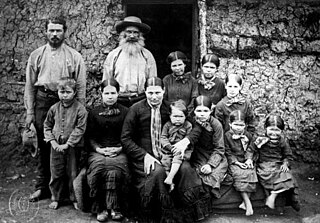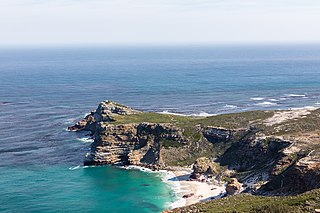| |||||||||
| Decades: | |||||||||
|---|---|---|---|---|---|---|---|---|---|
| See also: | |||||||||
The following lists events that happened during 1814 in South Africa .
| |||||||||
| Decades: | |||||||||
|---|---|---|---|---|---|---|---|---|---|
| See also: | |||||||||
The following lists events that happened during 1814 in South Africa .

Boers are the descendants of the proto Afrikaans-speaking Free Burghers of the eastern Cape frontier in Southern Africa during the 17th, 18th, and 19th centuries. From 1652 to 1795, the Dutch East India Company controlled the Dutch Cape Colony, which the United Kingdom incorporated into the British Empire in 1806. The name of the group is derived from Trekboer then later "boer", which means "farmer" in Dutch and Afrikaans.

Cape Town is the legislative capital of South Africa. It is the country's oldest city and the seat of the Parliament of South Africa. It is the country's second-largest city, after Johannesburg, and the largest in the Western Cape. The city is part of the City of Cape Town metropolitan municipality.

South African English is the set of English language dialects native to South Africans.

The Second Boer War, also known as the Boer War, Transvaal War, Anglo–Boer War, or South African War, was a conflict fought between the British Empire and the two Boer republics over the Empire's influence in Southern Africa.

The Cape of Good Hope is a rocky headland on the Atlantic coast of the Cape Peninsula in South Africa.

The Cape Colony, also known as the Cape of Good Hope, was a British colony in present-day South Africa named after the Cape of Good Hope. It existed from 1795 to 1802, and again from 1806 to 1910, when it united with three other colonies to form the Union of South Africa, then became the Cape Province, which existed even after 1961, when South Africa had become a republic, albeit, temporarily outside the Commonwealth of Nations (1961–94).

The Union of South Africa was the historical predecessor to the present-day Republic of South Africa. It came into existence on 31 May 1910 with the unification of the Cape, Natal, Transvaal, and Orange River colonies. It included the territories that were formerly part of the South African Republic and the Orange Free State.

The first modern humans are believed to have inhabited South Africa more than 100,000 years ago. South Africa's first known inhabitants have been collectively referred to as the Khoisan, the Khoekhoe and the San. Starting in about 400 AD, these groups were then joined by the Bantu ethnic groups who migrated from Western and Central Africa during what is known as the Bantu expansion. These Bantu groups were mainly limited to the area north of the Soutpansberg and the northeastern part of South Africa until the later Middle Iron Age, after which they started migrating south into the interior of the country.

The Great Trek was a northward migration of Dutch-speaking settlers who travelled by wagon trains from the Cape Colony into the interior of modern South Africa from 1836 onwards, seeking to live beyond the Cape's British colonial administration. The Great Trek resulted from the culmination of tensions between rural descendants of the Cape's original European settlers, known collectively as Boers, and the British. It was also reflective of an increasingly common trend among individual Boer communities to pursue an isolationist and semi-nomadic lifestyle away from the developing administrative complexities in Cape Town. Boers who took part in the Great Trek identified themselves as voortrekkers, meaning "pioneers" or "pathfinders" in Dutch and Afrikaans.

Coloureds are multiracial people in South Africa, Namibia and to a lesser extent, Zimbabwe and Zambia. Their ancestry descends from the interracial marriages/interracial unions that occurred between Europeans, Africans and Asians. Interracial mixing in South Africa began in the Dutch Cape Colony in the 17th century when the Dutch men mixed with Khoi Khoi women, Bantu women and Asian female slaves and mixed race children were conceived. Eventually, interracial mixing occurred throughout South Africa and the rest of Southern Africa with various other European nationals such as the Portuguese, British, Germans, and Irish, who mixed with other African tribes which contributed to the growing number of mixed-race people, who would later be officially classified as Coloured by the apartheid government.

Railways with a track gauge of 3 ft 6 in were first constructed as horse-drawn wagonways. The first intercity passenger railway to use 3 ft 6 in was constructed in Norway by Carl Abraham Pihl. From the mid-nineteenth century, the 3 ft 6 in gauge became widespread in the British Empire. In Africa it became known as the Cape gauge as it was adopted as the standard gauge for the Cape Government Railways in 1873, although it had already been established in Australia and New Zealand before that. It was adopted as a standard in New Zealand, South Africa, Indonesia, Japan, the Philippines, Taiwan, and Queensland in Australia.

The area known today as Cape Town has no written history before it was first mentioned by Portuguese explorer Bartholomeu Dias in 1488. The German anthropologist Theophilus Hahn recorded that the original name of the area was '||Hui !Gais' – a toponym in the indigenous Khoi language meaning "where clouds gather."

South Africa, officially the Republic of South Africa (RSA), is the southernmost country in Africa. Its nine provinces are bounded to the south by 2,798 kilometres of coastline that stretches along the South Atlantic and Indian Ocean; to the north by the neighbouring countries of Namibia, Botswana, and Zimbabwe; to the east and northeast by Mozambique and Eswatini; and it encloses Lesotho. Covering an area of 1,221,037 square kilometres, the country has over 62 million people. Pretoria is the administrative capital, while Cape Town, as the seat of Parliament, is the legislative capital. Bloemfontein has traditionally been regarded as the judicial capital. The largest and most populous city is Johannesburg, followed by Cape Town and the busiest port city in sub-Saharan Africa, Durban.
Afrikaners are a Southern African ethnic group descended from predominantly Dutch settlers first arriving at the Cape of Good Hope in 1652. Until 1994, they dominated South Africa's politics as well as the country's commercial agricultural sector.

The Coloured vote constitutional crisis, also known as the Coloured vote case, was a constitutional crisis that occurred in the Union of South Africa during the 1950s as the result of an attempt by the Nationalist government to remove coloured voters in the Union's Cape Province from the common voters' rolls. It developed into a dispute between the judiciary and the other branches of government over the power of Parliament to amend an entrenched clause in the South Africa Act and the power of the Appellate Division to overturn the amendment as unconstitutional. The crisis ended when the government enlarged the Senate and altered its method of election, allowing the amendment to be successfully enacted.

The Auwal Mosque, alternatively spelled Awwal, Owal or Owwal, is a mosque in the Bo-Kaap neighbourhood of Cape Town, South Africa. It was completed in 1794 and was the first mosque established in South Africa.

South Africa – Sri Lanka relations refers to the current and historical relations between South Africa and Sri Lanka. The Government of South Africa established its resident diplomatic mission in Colombo in September 2007. HE Sirisena Amarasekara is the current Sri Lankan High Commissioner to South Africa while HE Ms RP Marks is the current South African High Commissioner to Sri Lanka. Both countries are members of the Commonwealth of Nations.

Regiment University of Cape Town was an artillery regiment of the South African Army. As a reserve unit, it had a status roughly equivalent to that of a British Army Reserve or United States Army National Guard unit. It was part of the South African Army Artillery Corps.

Swellendam Commando was a light infantry regiment of the South African Army. It formed part of the South African Army Infantry Formation as well as the South African Territorial Reserve.
The following index is provided as an overview of and topical guide to the protected areas of South Africa:
See Years in South Africa for list of References